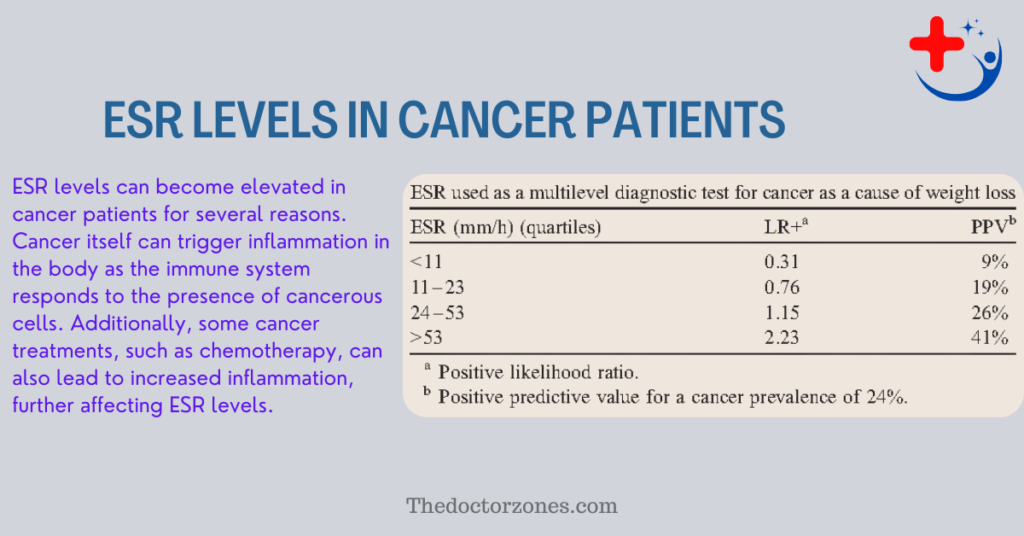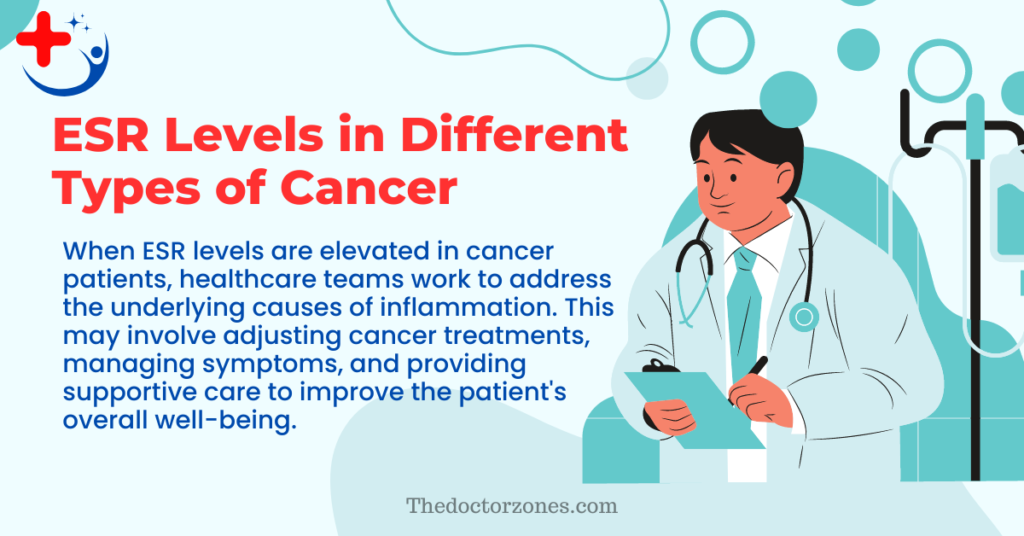What Is The ESR Level in Cancer Patients
ESR stands for “Erythrocyte Sedimentation Rate,” and it is a blood test used to measure the rate at which red blood cells settle to the bottom of a test tube over a specified period of time. It is a non-specific marker of inflammation in the body and is not directly related to cancer itself. However, in cancer patients, elevated ESR levels can sometimes be seen as a result of the body’s response to cancer-related inflammation or other underlying health issues. Read More Is Emphysema Cancer
Erythrocyte Sedimentation Rate (ESR) is a critical blood test used widely in medical diagnostics to measure the rate at which red blood cells settle at the bottom of a test tube over a specified period. Although ESR is a non-specific marker of inflammation, it plays a significant role in the diagnosis, monitoring, and treatment of cancer patients. This comprehensive guide explores the intricacies of ESR levels in cancer patients, highlighting its clinical implications and the factors influencing ESR variations. Discover How Does Cancer Man Test You
2. What is ESR?
Definition and Overview
ESR stands for Erythrocyte Sedimentation Rate. It is a blood test that measures the rate at which red blood cells (erythrocytes) settle to the bottom of a test tube over one hour. The rate is measured in millimeters per hour (mm/hr). ESR is a non-specific marker of inflammation and is used to detect and monitor various conditions, including infections, autoimmune diseases, and cancers. Also read the Article: What is Kydae Cancer
How ESR is Measured
The test involves taking a blood sample from the patient and placing it in a tall, thin tube. The sample is left undisturbed for one hour, and the rate at which red blood cells fall is measured. A higher rate indicates increased inflammation in the body.
3. Normal ESR Levels

What is the Normal ESR Level in Cancer Patients?
In healthy individuals, normal ESR levels are generally low. However, in cancer patients, ESR levels can vary significantly based on the type and stage of cancer, as well as the patient’s overall health and the presence of other medical conditions.
Normal ESR Ranges by Age and Gender
- Men under 50 years: Below 15 mm/hr
- Men above 50 years: Below 20 mm/hr
- Women under 50 years: Below 20 mm/hr
- Women above 50 years: Below 30 mm/hr
- Newborns: 0 to 2 mm/hr
- Children (Neonatal period to puberty): 3 to 13 mm/hr
4. ESR Levels in Cancer Patients
How Does ESR Level Affect Cancer Diagnosis?
Elevated ESR levels can be an indication of inflammation caused by cancer. While a high ESR is not specific to cancer, it can prompt further diagnostic investigations. In the context of cancer, ESR levels help provide insights into the extent of inflammation, which may correlate with cancer activity.
ESR Level in Cancer Patients with Inflammation
Inflammation is a common response in cancer patients, either due to the cancer itself or as a reaction to treatments such as chemotherapy. Elevated ESR levels in cancer patients often reflect this inflammation, making it a valuable marker for assessing the body’s inflammatory response.
High ESR Level in Cancer Prognosis
High ESR levels are often associated with poor prognosis in cancer patients. Research has shown that elevated ESR levels correlate with more advanced disease stages and poorer outcomes. This makes monitoring ESR levels crucial in predicting patient survival and adjusting treatment plans accordingly.
Low ESR Level in Cancer Patients
Although less common, some cancer patients may have low ESR levels. This can occur in certain cancer types or stages where inflammation is minimal or in cases where patients are responding well to treatment. Low ESR levels may also indicate less aggressive disease.
5. Factors Influencing ESR Levels in Cancer Patients
Correlation Between ESR Level and Cancer Progression
The relationship between ESR levels and cancer progression is significant. Higher ESR levels often indicate more aggressive cancer and greater inflammatory response, whereas stable or decreasing ESR levels can signal effective treatment and disease control.
Why is ESR Level Elevated in Cancer Patients?

Several factors contribute to elevated ESR levels in cancer patients:
- Inflammatory Response: Cancer triggers the release of inflammatory cytokines, increasing ESR.
- Tumor Burden: Larger or metastatic tumors cause more inflammation, raising ESR levels.
- Treatment Effects: Chemotherapy and other treatments can cause tissue damage and inflammation, leading to higher ESR.
6. Monitoring ESR Levels in Cancer Treatment
ESR Level Monitoring in Cancer Treatment
Regular monitoring of ESR levels helps healthcare providers track the effectiveness of cancer treatments. A declining ESR level typically indicates a positive response to treatment, while rising levels may suggest disease progression or the need for treatment adjustments.
ESR Level Significance in Oncology
ESR levels are significant in oncology for several reasons:
- Diagnostic Clues: Elevated ESR can prompt further diagnostic tests for cancer.
- Treatment Monitoring: ESR helps assess how well a patient is responding to treatment.
- Prognostic Indicator: ESR levels can indicate the likely course and outcome of the disease.
7. Clinical Implications of ESR Levels in Cancer
The clinical implications of ESR levels in cancer are profound. Elevated ESR levels can indicate the need for more aggressive treatment, signal complications such as infections, and provide a gauge for treatment efficacy. Understanding ESR levels helps healthcare providers deliver more personalized and effective cancer care.
8. Conclusion
ESR is a valuable tool in the diagnosis, monitoring, and management of cancer. By understanding ESR levels and their implications, healthcare providers can better assess inflammation, track disease progression, and tailor treatments to improve patient outcomes. Regular monitoring of ESR levels, combined with other diagnostic tools, offers a comprehensive approach to cancer care.
9. FAQs
Q1. Can high ESR levels definitively indicate cancer?
A: No, high ESR levels can suggest the presence of inflammation, which may be related to cancer, but they are not a definitive diagnostic tool for cancer. Further tests are needed for a precise diagnosis.
Q2. What other conditions can cause elevated ESR levels?
A: Elevated ESR levels can result from various inflammatory conditions, such as infections, autoimmune diseases, and certain medications.
Q3. Are there ways to reduce elevated ESR levels in cancer patients?
A: Managing elevated ESR levels often involves treating the underlying cause, such as cancer or treatment-related inflammation. Consultation with a healthcare team is crucial.
Q4. Can ESR levels be used to track cancer remission?
A: Yes, a decrease in ESR levels over time can be an indicator of a positive response to cancer treatment and potential remission.
Q5. How frequently should ESR levels be monitored in cancer patients?
A: The frequency of ESR monitoring can vary depending on the patient’s specific condition and treatment plan. Healthcare professionals will determine the appropriate schedule.
Q6. What is the significance of normal ESR levels in cancer patients?
A: Normal ESR levels in cancer patients can indicate minimal inflammation and may suggest that the disease is well-managed or less aggressive.
Q7. How does inflammation affect ESR levels in cancer patients?
A: Inflammation increases the release of inflammatory cytokines, which raises ESR levels. This can result from the cancer itself or from treatments like chemotherapy.
Q8. Can low ESR levels occur in cancer patients?
A: Yes, low ESR levels can occur in cancer patients, particularly if the inflammation is minimal or the patient is responding well to treatment.
Q9. Why is regular ESR testing important in cancer care?
A: Regular ESR testing helps track inflammation, monitor treatment effectiveness, and detect complications early, providing a comprehensive picture of the patient’s health.
Q10. How do ESR levels correlate with cancer progression?
A: Higher ESR levels are often associated with more advanced and aggressive cancer, whereas stable or decreasing levels can indicate effective treatment and disease control.








